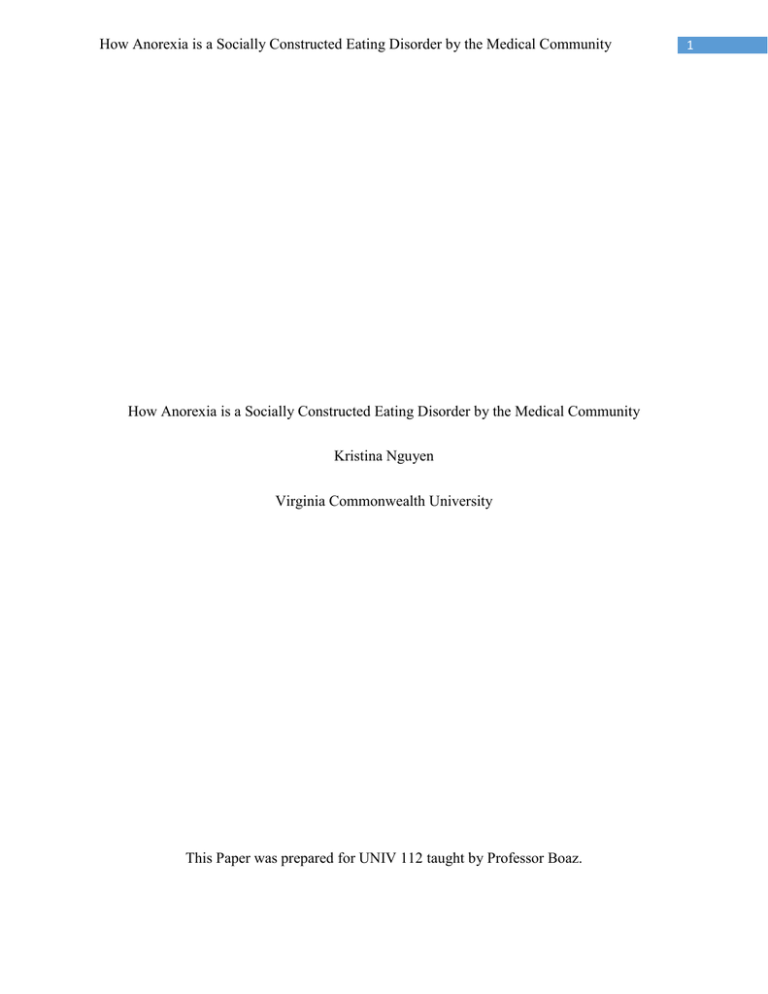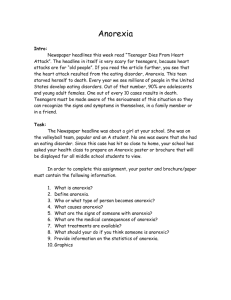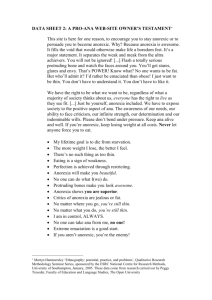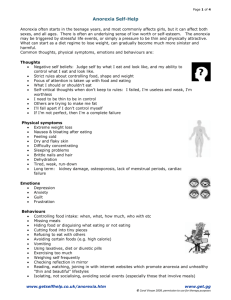How Anorexia is a Socially Constructed Eating Disorder by the
advertisement

How Anorexia is a Socially Constructed Eating Disorder by the Medical Community How Anorexia is a Socially Constructed Eating Disorder by the Medical Community Kristina Nguyen Virginia Commonwealth University This Paper was prepared for UNIV 112 taught by Professor Boaz. 1 How Anorexia is a Socially Constructed Eating Disorder by the Medical Community How Anorexia is a Socially Constructed Eating Disorder by the Medical Community Annette, a patient in Bruch’s (1982) study has suffered from anorexia nervosa, and was a pure anorexic, meaning she lost weight as a result of food restricting and exercises. Annette grew up in the capital of a Western state, and is the youngest of a large family. For Annette, her family played an essential role in her life. Most of her family members were tall and slim, and after her older sister has gained weight while living in boarding school, the importance of staying slim was ingrained into Annette’s mind. According to her pediatrician, she was a healthy child growing up, but Annette described herself as “chubby” when she was 9 years old (Bruch, 1982, p.2). At the age of 13, Annette experienced her growth spurt, though she failed to gain weight that corresponded to their increase in height. From this point, anorexia took a stronger hold in her life, and she was in and out of treatment, with her lowest weight being 70 pounds. However, after being released from treatment and visiting friends and family for several weeks, she went down to 80 pounds because she wanted to maintain her image of one who does not eat much. She had realized from a young age that men could eat as much as they desired, while women were expected to be dainty and slim. Thus, like many others who suffer from anorexia, Annette felt social pressure from the women gender role, which ultimately caused the development of her anorexia. Anorexia is an eating disorder that can affect both genders, though it has been socially constructed to be feministic by the medical community. While anorexia has been around for a long time, it was not medically discovered until 1874 by William Gull (Till, 2011, p. 2). William Gull, a physician, coined the term anorexia when he noticed the symptoms of emaciation, and failed to find a biological reason for the appearance. As a result, Gull concluded it was a mental illness that caused the emaciated appearance. Since then, more studies and observation has been done, and there is a better 2 How Anorexia is a Socially Constructed Eating Disorder by the Medical Community medical symptoms and results from anorexia. Anorexia is an eating disorder and characterized by extreme weight loss due to starvation of oneself, and can ultimately be fatal (Smith and Segal, 2014, p. 1). At the mention of anorexia, the image typically associated is a severely underweight girl. In reality, according to Anorexia Nervosa (2013), 90% of those suffering from anorexia are female, and 10% of those suffering from anorexia are male, a less commonly known fact (p.1). There are two different types of anorexia, restriction of food or purging (Smith and Segal, 2014, p. 1). Anorexics that restrict their food will only permit themselves to eat a certain amount of calories a day and exercise constantly, where as anorexics that binge, vomit often or use laxatives (Smith and Segal, 2014, p.1). No matter which form of anorexia a person suffers from, they all share a “fear of gaining weight, low self-esteem and their inability to grasp the seriousness of their eating disorder” (Smith and Segal, 2014, p. 1). Lastly, of mental health conditions, anorexia is one of the main causes of death, typically appearing during the teenage years. Anorexia is a deadly eating disorder with many theories about its origin. From the discovery of anorexia, the first major theory about anorexia that was accepted by scholars was hypothesized by Hilde Bruch (Till, 2011, p. 2). Bruch was a German born psychoanalysis, who immigrated to the United States in 1934. After having studied many who suffered from anorexia, she theorized that anorexia is caused by a conflict of internal and external factors. According to Bruch (1982), the internal factors include the psyche of the person and their personal dilemmas, while the external factors include the society the person lives in and the Western society’s culture (p.2). These claims of Bruch were derived from the “mother’s failure to recognize and confirm the child’s expression of independent needs,” which caused the conflict that the person was dealing with. Indicated in Till’s (2011) article, Bruch were derived from the “mother’s failure to recognize and confirm the child’s expression of independent 3 How Anorexia is a Socially Constructed Eating Disorder by the Medical Community needs,” which caused the conflict that the person was dealing with (p.2). In directly placing the blame on the mother’s inadequacies, Bruch made her theory easily adaptable to femininity because the mother figure in a family is associated with femininity. Bruch’s theory was the beginning, but it was later used as the foundation for the medical community and feminists. Medicine is based on science, which relies mainly on numbers, however observation are also used. For this reason, when it was found that 90% of those who suffer from anorexia are female, leaving 10% of those who suffer from anorexia male, it suggest “there was a growing consensus that some relationship between anorexia and femininity existed” (Till, 2011, p. 6). Till (2011) focuses on the abundance of studies and research attempting to link anorexia to femininity, though there is still no conclusive link between femininity and anorexia. Psychiatrists created gender identity scales as one of the attempts to link anorexia to femininity. Rather than focusing on the social and cultural forces that may cause the development of anorexia, psychiatrist concentrated on individuals who showed personality traits that are associated with femininity. Terman and Miles created the first gender identity scale, and many more have been created since to accommodate the inadequacies of the previous scales. The most popular gender identity scale is the Bem Sex Role Inventory (BSRI), created by Bem. Bem developed an inventory of characteristics that were considered to be desirable for men or women based on American culture. However, the main issue with the gender identity scales is that at its core, it still categorically constructs femininity and masculinity in relation to the culture of the society. These gender identity scales were also biased in the sense that they facilitated the relation between anorexia and femininity. From these various gender identity scales, it has been found that those who suffer from anorexia have a lower masculinity score compared to the controls, those who did not suffer from anorexia. In general, the medical community has followed the 4 How Anorexia is a Socially Constructed Eating Disorder by the Medical Community same path as feminist in attempting to use science to say that those who are more feminine are more likely to be anorexic. The medical community is trusted and highly respected by the general population. Thus, the medical community being affected by the social and cultural norms contradicts the objectivity that is expected in the field of science. The subjectivity of the medical community results in an unethical treatment when dealing with those who suffer from anorexia. In a study by Murray and Touyz (2012), it was found that those in treatment who are classified and told that they have either anorexia or an eating disorder typically stay in treatment longer (p.3). These patients stay in treatment longer because they have now been labeled anorexic and will continue to exhibit the anorexic symptoms and characteristics because that is what they believe is expected of them. In addition, attempting to link anorexia and femininity together has caused the general population to connote anorexia with women and women gender roles. As a result, females are highly criticized and judged about the amount of food they eat. For example, a female who eats very little will be considered to be thin and possibly anorexic, which makes diagnosing her easier, but girls and women then are more critical of what they eat and how it is perceived by society. Inversely, a male who eats very little is not obvious, which means that diagnoses becomes harder, and it becomes harder to receive treatment. The difficulty of diagnosing anorexia in males apparent in McVittie et al. (2005) experiment, 12 college boys were interviewed , and McVittie et al. discovered that diagnosing anorexia in men “presents a double challenge to masculine identities” (p. 9). It poses as a challenge because men are expected to accept their symptoms stoically rather than seeking medical intervention and it is considered feminine to have a “women’s condition” (McVittie et al., 2005, p. 9). The 5 How Anorexia is a Socially Constructed Eating Disorder by the Medical Community subjectivity of how the medical community has caused unethical treatment of both genders in treatment and diagnoses of anorexia. Similar to the medical community, feminists took Bruch’s theory and altered it in such a way to support their perspective. Sociologically, feminism is about how society and culture is constructed in such a manner that it is disadvantageous to women. In most societies, the social expectations results in two distinct genders, man and women. It is important to note that when talking about feminism, feminists focus on the disadvantageous that women have due to social norms and gender roles. The first part of Bruch’s theory states that one who suffers from anorexia is dealing with conflict that result from internal and external factors, with the external factors being society and culture. The feminists responded to this theory by stating that the eternal factors were specifically media and the expected gender roles of women in Western societies. In Western societies, women are expected to be slender, since there is a negative connotation to being obese or overweight, and to please men, either through staying slender or being sexual attractive. All of these expectations of how women should appear and act are primarily transmitted through the media, such as magazines, movies and music videos. Feminists argue that given the gender roles of women in Western societies, women are disadvantaged and more prone to develop anorexia. Now, one who argues that anorexia is a feminine eating disorder could take on the feminist approach that the media has created an unattainable image and expectation for women. From a young age, girls are bombarded with what they are supposed to become and what looks “sexy” from magazines and the ideals passed from older girls and friends. For example, the popular magazines like People and USA Today have pictures and pictures of models with the “perfect body,” and articles about how women are supposed to behave (McVittie et al, 2005, 6 How Anorexia is a Socially Constructed Eating Disorder by the Medical Community p.5). About 25% of kids at the tender age of 8 are dissatisfied with a part of their body (Murray and Touyz, 2012, p. 4). The bombardment of women with perfect bodies in the media, when in reality they are airbrushed and photo shopped, along with certain characteristic might lead to the dissatisfaction of the body, eventually leading to anorexia. As Till (2011) emphasizes from recent studies and the gender identity scales, it is believed that femininity predisposes a person to anorexia, while masculinity protects a person from anorexia (p.5). The gender identity scales support this theory, and the statistics also support this, but recent research has shed some light. McVittie et al (2005) experiment found that the number of males who are dissatisfied with their body is increasing, and nearly equal to that of women who are dissatisfied with their body (p.1). In fact, 95% of males in college are dissatisfied with their body. In an experiment, when men where asked about the pictures in the media, they responded by saying that while they do look at the picture, they do not compare their body to the picture, but rather use it to keep on fashion trends and such. While feminists attempt to blame media for the development of anorexia in females, there is empirical data that proves otherwise. Similar to how anorexia is socially constructed for females, Murray and Stephens’ (2012) experiment found that muscle dysmorphia is on the rise, and it is socially constructed for men. Muscle dysmorphia is similar to anorexia, but manifests in the dissatisfaction with the amount of muscles a person has. Rather than starving themselves, those who suffer from muscle dysmorphia will constantly work out because they believe they do not have enough muscle, and go beyond the point that is healthy. 90% of those with muscle dysmorphia are male, leaving 10% of those with muscle dysmorphia female. The statistics for anorexia and muscle dysmorphia are opposite, and it shows that while femininity is a predisposition to anorexia, it protects against muscle dysmorphia. On the other hand, masculinity may protect one from developing anorexia, 7 How Anorexia is a Socially Constructed Eating Disorder by the Medical Community but make it more likely to develop muscle dysmorphia. The socially construction of muscle dysmorphia further strengthens the argument that anorexia is socially constructed because both anorexia and muscle dysmorphia are drive by their respective gender roles. Women are expected to be dainty and thin, resulting in anorexia, while men are expected to be strong and stoic, resulting in muscle dysmorphia. In conclusion, from the beginning, anorexia was inadvertently socially constructed by the medical community to be feminine. Starting from Hilde Bruch’s theory to the numerous studies done about anorexia, it has all been centered on trying to find the link between anorexia and femininity. To this day though, there still is no conclusive relationship between the two. As cited in McVittie et al. (2005), “there are limited data concerning the prevalence of this (anorexia) disorder in males” (p.1). Thus from the medical community and the feminists theory, anorexia will continue to be perpetuated as a feminine based on the social construction of the gender roles of women. 8 How Anorexia is a Socially Constructed Eating Disorder by the Medical Community References Anorexia Nervosa. (2013). Retrieved November 4, 2014, from National Eating Disorder Association website: https://www.nationaleatingdisorders.org/ anorexia-nervosa Bruch, H. (1982). Psychotherapy in Anorexia Nervose. International Journal of Eating Disorders, 1(4), 3-14. Retrieved from http://web.b.ebscohost.com/ ehost/pdfviewer/pdfviewer?sid=c1ec8cf3-fab9-40cd-ada19a66c8e70860%40sessionmgr115&vid=4&hid=116 McVittie, C., Cavers, D., & Hepworth, J. (2005). Femininity, Mental Weakness, and Difference: Male Students Account for Anorexia Nervosa in Men. Sex Roles, 53(5), 413-418. Retrieved from http://web.b.ebscohost.com/ehost/ pdfviewer/ pdfviewer?vid=6&sid=c1ec8cf3-fab9-40cd-ada19a66c8e70860%40sessionmgr115&hid=116 Murray, S. B., & Touyz, S. W. (2012). Masculinity, Femininity and Male Body Image: A Recipe for Future Research. International Journal of Men's Health, 11(3), 227-239. Smith, M., & Segal, J. (2014, October). Anorexia Nervosa Signs, Symptoms, Causes, and Treatment. Retrieved November 4, 2014, from Helpguide.org website: http://www.helpguide.org/articles/eating-disorders/ anorexia-nervosa.htm Til, C. (2011). The quantification of gender: Anorexia nervosa and femininity. Health Sociology Review, 20(4), 437-449. Retrieved from http://web.a.ebscohost.com 9 How Anorexia is a Socially Constructed Eating Disorder by the Medical Community /ehost/pdfviewer/ pdfviewer?vid=4&sid=88de87cb-1cec-4d14-ba3c91194000f2e2%40sessionmgr4002&hid=4112 10






